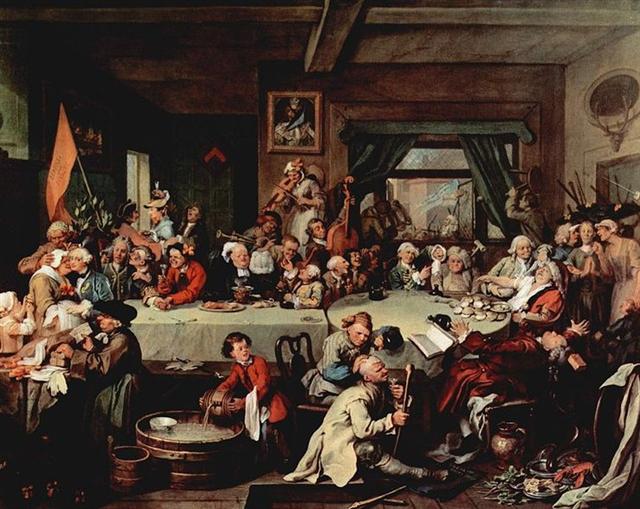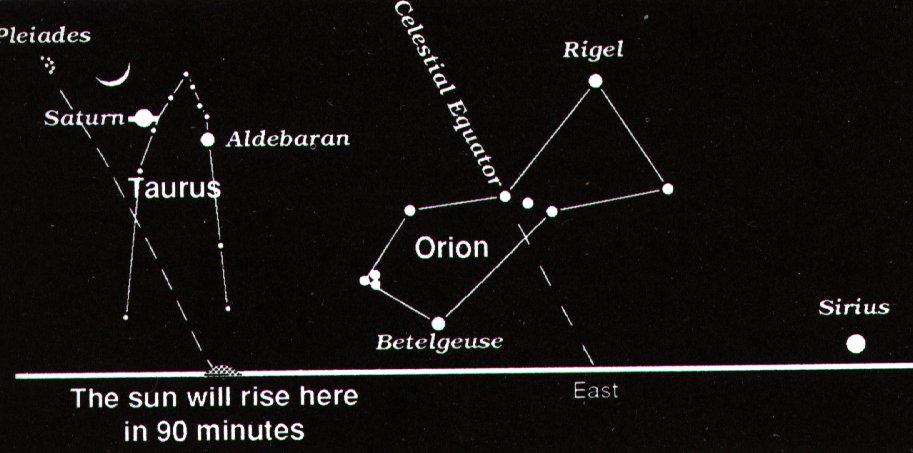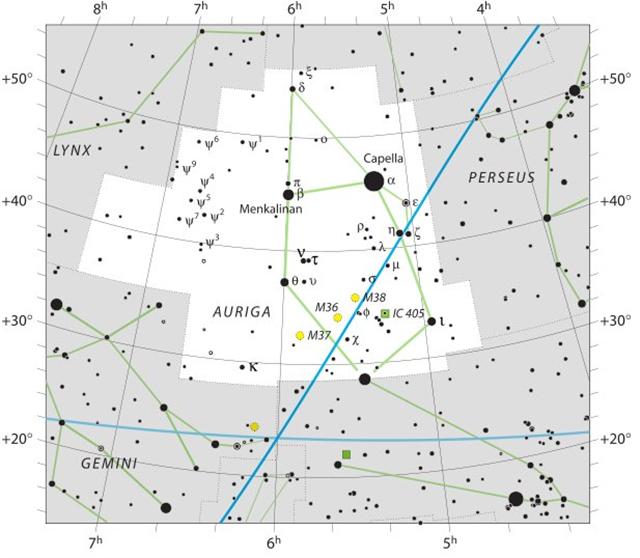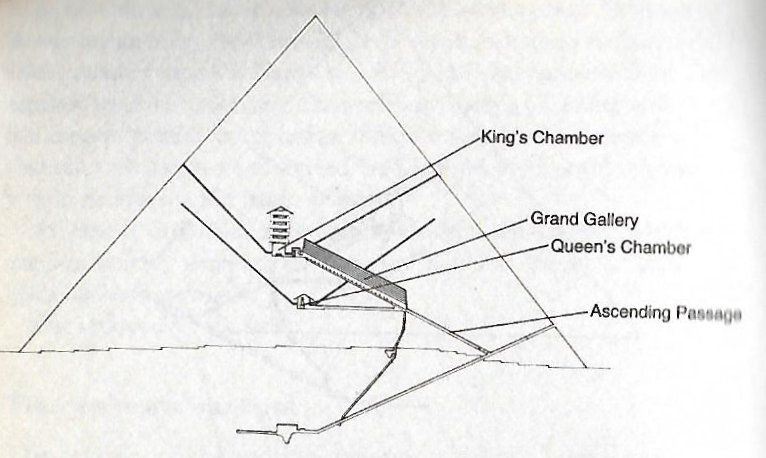|
GLYPHS
Aa6-66-6 The Pleiades were not visible at all the times. There was a month when they were absent - when they were 'seriously ill':
... Ebony label EA 32650 from Den's tomb. The upper right register depicts king Den twice: at the left he is sitting in his Hebsed pavilion, at the right he is running a symbolic race around D-shaped markings. This ceremony is connected to the so-called 'race of the Apis bull'. The middle right section reports about the raid of the city 'beautiful door' and about a daughter of Den suffering from an unknown disease ... ... The Pleiades are situated 24░ above the celestial equator at the present time on the circle which marks the northern limit of the Sun in declination [23░26′ 22″].
They rise soon after sunset on November 20, are on the merididan at sunset about February 20, and set in the rays of the setting Sun toward the end of April. Thirty of forty days later they are visible on the eastern horizon just before dawn. The period of invisibility was a time of anxiety to the Indians of Paraguay who believed their ancestor, the Pleiades, to be seriously ill. The return of the cluster to the early morning sky was saluted with festivals of thanksgiving generally throughout South America. It is curious to find two peoples as far apart as the Indians of Paraguay and the Polynesians of Pukapuka calling themselves descendants of the Pleiades. The Blackfoot Indians of North America held solemn vigils at the beginning and end of the period of invisibility. Tribes of Brazil venerated the Pleiades as having special influence over human destinies, as did the aborigines of Australia who sang and danced to pleas and propitiate these fateful little stars. Peruvian Indians worshipped the Pleiades as having power over the growth of corn and the great Inca temple at Cuzco had a hall dedicated to the cluster. In the Polynesian tongue Matariki, the name for the Pleiades, is contracted from Mata-ariki, high-born or regal stars. We must look for the explanation of the association of the Pleiades with the agricultural seasons on which early man depended for his chances of survival far in the past, for the cult of the Pleiades certainly dates from remote antiquity. Owing to the precession of the equinoxes the cluster is now 30░ farther east of the vernal equinox than it was 2,000 years ago, when it was also 7░ closer to the celestial equator. Some 4,000 years ago it was situated about 10░ north of the vernal equinox. In that position their early morning rising ushered in the spring and the planting season in the northern hemisphere. Whatever may have been the reason for the preŰminence of the Pleiades cluster - and it was probably a combination of several reasons - it is certain that when men became increasingly alert ot the annual cycles of celestial phenomena, the changing altitudes and azimuths of the Sun, the lengthening and shortening of days and the corresponding variation in temperature, the slow march of the constellations across the sky, and realized the need of choosing a day on which to begin the yearly cycle of the calendar, they turned to the Pleiades for guidance. Undoubtedly the Polynesians carried the Pleiades year with them into the Pacific from the ancient homeland of Asia. With but few exceptions they continued to date the annual cycle from the rising of these stars until modern times. In the Hawaiian, Samoan, Tongan, Society, Marquesan, and some other islands the new year began in late November or early December with the first new Moon after the first appearance of the Pleiades in the eastern sky in the evening twilight. Notable exceptions to the general rule are found in Pukapuka and among certain tribes of New Zealand where the new year was inaugurated by the first new Moon after the Pleiades appeared on the eastern horizon just before sunrise in June. Traces of an ancient year beginning in May have been noted in the Society Islands, but there is some uncertainty about the beginning of the year in native annals generally, at least as reported by missionaries and others, due perhaps to the desire to make the Polynesian months coincide with the stated months of the modern calendar. In view of the almost universal prevalence of the Pleiades year throughout the Polynesian area it is surprising to find that in the South Island and certain parts of the North Island of New Zealand and in the neighboring Chatham Islands, the year began with the new Moon after the yearly morning [heliacal] rising, not of the Pleiades, but of the star Rigel in Orion. Such an important difference can be explained only on the assumption that the very first settlers from the west brought the Rigel year with them, perhaps from New Guinea or Java of some other land 10░ south of the equator where Rigel acquired at the same time its synonymity with the zenith. Colonists who arrived in New Zealand from Central Polynesia during the Middle Ages and intermarried with the tangata whenua, 'people of the land', found themselves between the horns of a calendrical dilemma. They must either convert the aborigines to the Pleiades year beginning in November-December or themselves adopt the Rigel year and bring down the wrath of their ancestors on their own heads. That there resulted a long and passionate struggle on the part of both the invaders and the invaded to retain their own the integrity of the sacred year of their traditions can hardly by doubted. The outcome of the conflict proved that the institution of the land was too firmly established to be changed. While some tribes retained the Rigel year in its entirety others effected a compromise by retaining the Pleiades year but commencing it in June ... Thus this phase of the Pleiades year in a way could be compared to the 29th black night of the Moon. 364 - 290 = 74:
The total number of glyphs on the C tablet is 740. Possibly we should add 10(0) to 64(0) in order to count from the December solstice instead of from January 1 (= 364 + 1):
... Gregory dropped 10 days to bring the calendar back into synchronisation with the seasons. Accordingly, when the new calendar was put in use, the error accumulated in the 13 centuries since the Council of Nicaea was corrected by a deletion of ten days. The Julian calendar day Thursday, 4 October 1582 was followed by the first day of the Gregorian calendar, Friday, 15 October 1582 (the cycle of weekdays was not affected) ...
And yet more confusing was the change of the date for 0h: ... Taetagaloa goes right over there and steps forward to the stern of the canoe saying - his words are these: 'The canoe is crooked.' (kalo ki ama). Instantly Likāvaka is enraged at the words of the child. Likāvaka says: 'Who the hell are you to come and tell me that the canoe is crooked?' Taetagaloa replies: 'Come and stand over here and see that the canoe is crooked.' Likāvaka goes over and stands right at the place Taetagaloa told him to at the stern of the canoe. Looking forward, Taetagaloa is right, the canoe is crooked. He slices through all the lashings of the canoe to straighten the timbers. He realigns the timbers. First he must again position the supports, then place the timbers correctly in them, but Kuikava the son of Likāvaka goes over and stands upon one support. His father Likāvaka rushes right over and strikes his son Kuikava with his adze. Thus Kuikava dies. Taetagaloa goes over at once and brings the son of Likāvaka, Kuikava, back to life. Then he again aligns the supports correctly and helps Likāvaka in building the canoe. Working working it is finished ...
... The Sun-god thence climbed up the mother-mountain of the Kushika race as the constellation Hercules, who is depicted in the old traditional pictorial astronomy as climbing painfully up the hill to reach the constellation of the Tortoise, now called Lyra, and thus attain the polar star Vega, which was the polar star from 10000 to 8000 B.C. May not this modern companion constellation, Mons Maenalus, be from a recollection of this early Hindu conception of our Hercules transferred to the adjacent Bootes?
And on Easter Island there grew (in the water - noho te vai - of Rano Kau) a sacred Tree (rakau) named Toro-miro. In Spanish the Bull was El Toro. 261 = 9 * 29:
December 7 (341) - according to the Pope Gregory XIII - corresponded to day 80 + *261.4 - *41.4 = *220.0 + 80 = 300 according to the era of Bharani (*41.4). Here the Knot (Al-Risha, α Piscium) culminated (at 21h), it could be deduced from the (ideally) simultaneous culmination at the nakshatra Full Moon of Thuban. ... the target for the temporary dead God Pharaoh Knum Khufu ...
... For some reason, too, it had taken their fancy to place the Great Pyramid almost exactly on the 30th parallel at latitude 29║ 58' 51". This, a former astronomer royal of Scotland once observed, was 'a sensible defalcation from 30║', but not necessarily in error: For if the original designer had wished that men should see with their body, rather than their mental eyes, the pole of the sky from the foot of the Great Pyramid, at an altitude before them of 30║, he would have had to take account of the refraction of the atmosphere, and that would have necessitated the building standing not at 30║ but at 29║ 58' 22' ... And after 15 nights of invisibility due to the blinding rays from the Sun the Pleiades would return once again into full view in the early morning of MARCH 29:(13 + 16)
... The Mahabharata insists on six as the number of the Pleiades as well as of the mothers of Skanda and gives a very broad and wild description of the birth and the installation of Kartikeya 'by the assembled gods ... as their generalissimo', which is shattering, somehow, driving home how little one understands as yet. The least which can be said, assuredly: Mars was 'installed' during a more or less close conjunction of all planets; in Mbh. 9.45 (p. 133) it is stressed that the powerful gods assembled 'all poured water upon Skanda, even as the gods had poured water on the head of Varuna, the lord of waters, for investing him with dominion'. And this 'investiture' took place at the beginning of the Krita Yuga, the Golden Age ...
What, then, should we think about ku tupu te poporo?
|
||||||||||||||||||||||||||||||||||||||||||||||||||||||||||||||||||||||||||||||||||||||||||||||||||||||||||||||||||||||||||||||||||||||||||||||||||||||||||||||||||||||||||||||||||||||||||||||||||||||||||||||||||||||||||||||||||||||||||||||||||||||||||||||||||||||||||||||||||||||||||||||||||||||||||||||||||||||||||||||||||||||||||
.jpg)




.jpg)













